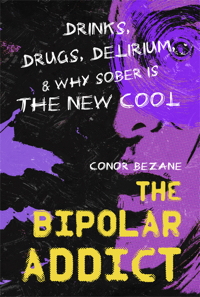 It was in rehab in 2012 that I decided to carry the flag for the mentally ill. I’d received my diagnosis of bipolar four years earlier and ended up in treatment because I was drinking two six-packs of beer or two bottles of wine — or more — every night. I was also smoking crack with homeless people a couple times a week and, for good measure, snorting heroin on occasion.
It was in rehab in 2012 that I decided to carry the flag for the mentally ill. I’d received my diagnosis of bipolar four years earlier and ended up in treatment because I was drinking two six-packs of beer or two bottles of wine — or more — every night. I was also smoking crack with homeless people a couple times a week and, for good measure, snorting heroin on occasion.
My sister, Colleen, could always smell alcohol on my breath even though I was never a day-drinker. Because after a night of heavy drinking, your breath still reeks of alcohol the next day. She could also smell fumes emanating from my pores. No matter how much mouthwash I gargled and how much I scrubbed my body in the shower, the odor of alcohol permeated.
I was jonesing for the mania of bipolar, and being drunk was my best equivalent.
A few months before rehab, I took a drunken spill down the stairs, hitting my head on the edge of a wooden pillar, slashing my forehead open and breaking my nose. The gash required two inches of stitches.
When Colleen confronted me, stitches still crisscrossing my forehead and a bandage on my nose, I told her I’d only had three beers that night. She didn’t believe me — and rightfully so.
The evidence was stacking up against me, so my family staged an intervention in January 2012. After three sessions with an interventionist, I finally agreed to go to Hazelden Betty Ford for a six-week intensive outpatient program, known in recovery jargon as IOP.
Toward the end of our stints at Hazelden, we were each asked to tell our stories to the group. Everybody else cobbled together an unscripted speech, but I’m a writer so I wrote mine down. I clobbered my keyboard and, in three hours, I had my entire life boiled down to 13 pages. I read my story to the group and the overwhelming response I received became the impetus for writing a book.
There are books about bipolar and books about addiction, but almost none about the intersection of the two. In addition to my story, I wanted to tell the stories of other bipolar addicts. In effect, I wanted to fill in the gap, to write the book I wish had been available when I first decided to get sober. My book — The Bipolar Addict: Drinks, Drugs, Delirium, And Why Sober Is The New Cool — addresses issues of dual diagnosis head on.
The Bipolar Addict, due later this year, is my contribution to the cause. My hope is that the book will help “normies” better understand what we go through while also giving my fellow dually diagnosed comrades inspiration through sharing others’ successes and coping strategies.
In addition to the book, I also write about bipolar disorder and addiction on this blog. From psychology news to personal stories about bipolar celebrities and historical figures, my blog is an informational launchpad for all of us with the disorder.
My book and blog are my contribution to battling the mental health stigma that remains extremely oppressive. Diagnosed or not, one in five American adults struggles with mental illness of some kind every year. There are 5.7 million bipolar people in the U.S. according to the National Institute on Mental Health, and 60 percent of them are addicts.
Critical to this conversation are three points:
1.We are indeed respectable.
2.There is treatment available.
3.With the right diagnosis, medication, and therapy, most all of us can lead relatively normal lives.
I want to speak to this community in our own language and pinpoint ideas that will improve — and maybe even save — lives. If you are reading this, you are most likely bipolar or an addict or you have a loved one who is. Let’s learn lessons together and stamp out the stigma of living with mental illness. We don’t inhabit a perfect world, but we can strive for perfection even if it is unattainable. Salvation lies just around the corner. It’s just waiting to greet you.
This article originally appeared on the International Bipolar Foundation website.







